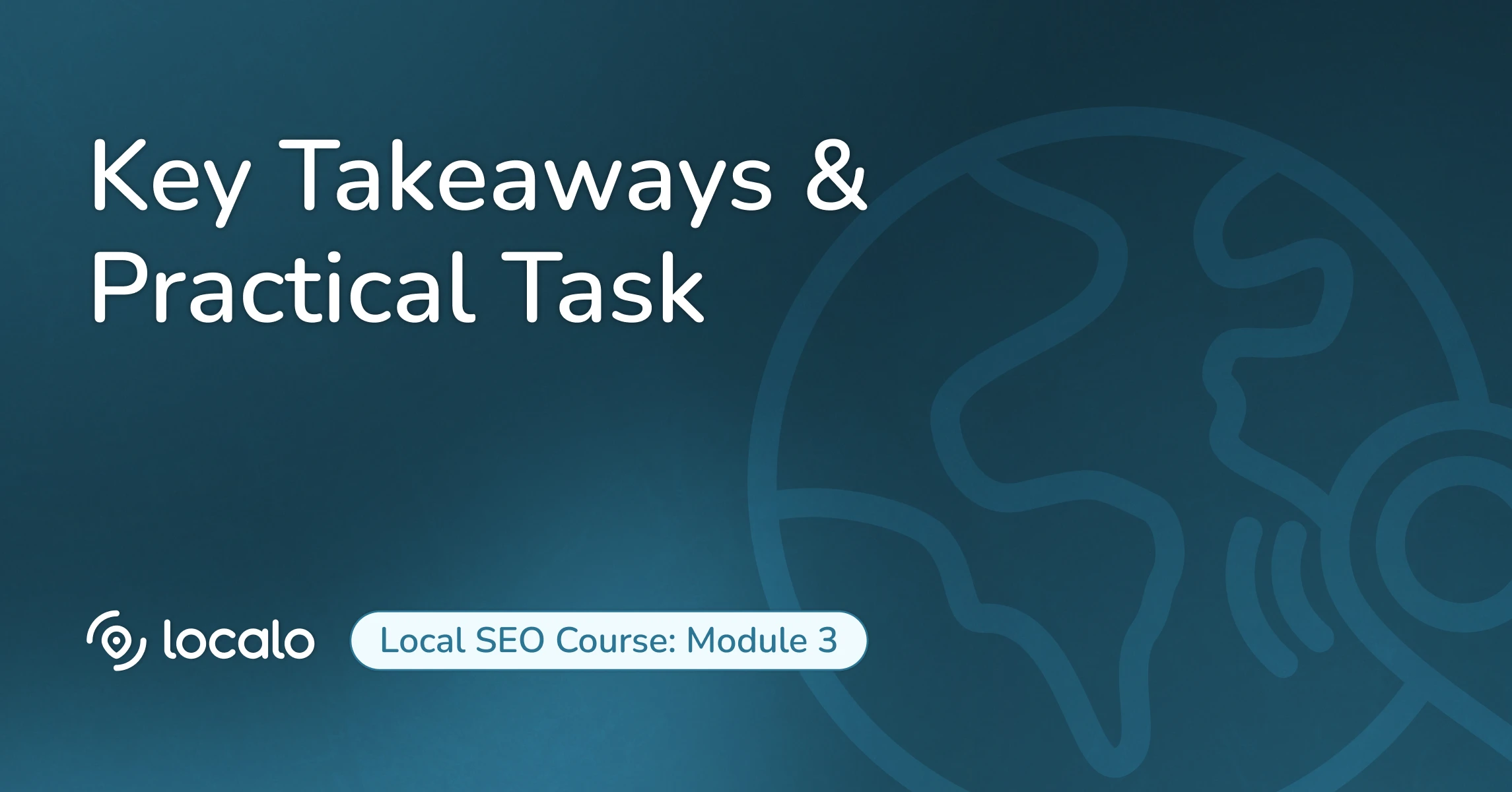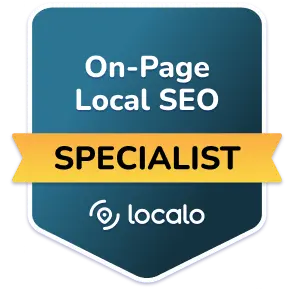While we’ve covered the foundational on-page elements, there are additional technical factors that impact your local search success. In upcoming modules, we’ll dive deeper into:
- Local schema markup that helps Google understand your business details
- Advanced technical SEO strategies for local search success
- User experience signals that influence rankings
These technical elements work together with everything you’ve learned here to create a comprehensive local SEO strategy.
Recap What You’ve Mastered
You’ve just learned the on-page essentials that separate successful local businesses from those struggling to get found online:
- On-page SEO is about organization and clarity - helping both Google and customers easily understand what you offer and where you serve.
- Strategy beats random tactics every time. Start with your homepage, focus on your revenue-driving pages, then expand to supporting content.
- Customer language trumps marketing speak. Listen to how your customers actually describe their problems and use their exact words.
- Focus beats breadth in keyword strategy. The 80-20 rule applies. Concentrate on your 3-5 money-making keywords instead of trying to rank for everything.
- More pages can hurt if they compete with each other. Page cannibalization is real and costly. When in doubt, consolidate into fewer, stronger pages.
- Small optimizations add up to big results. Proper title tags, headers, and internal linking might seem basic, but they’re the foundation everything else builds on.
- Mobile optimization is non-negotiable. Most local searches happen on mobile, so your mobile experience can make or break your success.
The beauty of on-page local SEO? These changes often show results within weeks, not months, because you’re competing locally rather than nationally. But timeframes vary significantly based on factors like site authority, competition, and the specific changes made. While some improvements may be visible within weeks, others may take months to fully manifest. Focus on making comprehensive improvements that your users expect.
Practical Tasks
Time to put your new knowledge to work. Here are specific tasks that will give you immediate improvements:
Task 1: Customer Language Detective Work (20 minutes)
- Review your last 10 customer interactions (calls, emails, reviews) and write down exactly how they described their problem or need.
- Search for your main service + city and screenshot the “People Also Ask” questions that appear.
- Create a simple list: customer language vs. how you currently describe your services. Note the gaps.
Task 2: Homepage 10-Second Test (15 minutes)
- Visit your homepage and time yourself: Can you identify what the business does, where they serve, and why you’d choose them within 10 seconds?
- Check your title tag (browser tab text) - does it include service + location + benefit?
- Identify one quick fix you can implement this week to improve clarity.
Task 3: Page Conflict Quick Check (25 minutes)
- List all your service/location pages that target similar keywords.
- Search for your main terms and see if multiple pages from your site appear in results (sign of cannibalization).
- Pick your strongest page for your most important keyword and note which weaker pages might need redirecting.
Task 4: Mobile Reality Check (10 minutes)
- Use your phone to visit your website and try to complete a typical customer action (find your phone number, read your services, contact you).
- Note any friction points where the mobile experience breaks down.
- Test your site with Google’s PageSpeed Insights tool.
In Module 4, we’ll dive into Content Strategy for Local Businesses, where you’ll learn how to create content that attracts local customers and builds your authority. The keyword foundation you’ve built here will make your content strategy incredibly effective.
Hey Local Business Champs! Welcome back to our Complete Local SEO Course!
You’ve mastered on-page optimization - your website is becoming a real customer-attracting machine! Today we’re wrapping up with your action plan and the key takeaways that separate successful local businesses from those struggling to get found online.
Great job making it this far! You’re building something really powerful, and now it’s time to put everything together into a plan that gets results.
What technical elements connect to future modules?
While we’ve covered the foundational on-page elements that will make the biggest difference for your business, there are additional technical factors that impact your local search success. Think of what we’ve covered as building the foundation and walls of your house - solid and essential. The technical stuff we’ll cover later is like the electrical and plumbing - important, but it only works well if the foundation is solid.
In upcoming modules, we’ll dive deeper into local schema markup that helps Google understand your business details with crystal clarity. We’ll cover advanced technical SEO strategies for local search success that can give you an edge over competitors. And we’ll explore user experience signals that influence rankings, because Google is paying more attention to how people actually interact with your website.
These technical elements work together with everything you’ve learned here to create a comprehensive local SEO strategy that dominates your market. But the beautiful thing is, the foundation we’ve built in this module will make all those advanced techniques much more effective.
What are the key takeaways from this module about on-page optimization?
You’ve just learned the on-page essentials that separate successful local businesses from those struggling to get found online. Let me break down the most important lessons, because these insights will guide everything you do going forward.
On-page SEO is about organization and clarity - helping both Google and customers easily understand what you offer and where you serve. It’s not about tricking search engines or stuffing keywords everywhere. It’s about being genuinely helpful and easy to understand.
Strategy beats random tactics every single time. Start with your homepage, focus on your revenue-driving pages, then expand to supporting content. Too many businesses try to optimize everything at once and end up making no real progress anywhere.
Customer language trumps marketing speak every day of the week. Listen to how your customers actually describe their problems and use their exact words. Stop using fancy industry jargon that nobody searches for, and start using the words your customers use when they have urgent problems.
Focus beats breadth in keyword strategy. The 80-20 rule applies here. Concentrate on your 3 to 5 money-making keywords instead of trying to rank for everything. You’ll see faster results and attract more qualified customers, especially if you lack resources to do more at once.
Page cannibalization is real and costly. More pages can hurt if they compete with each other. When in doubt, consolidate into fewer, stronger pages. One powerful page beats four weak pages every time.
Small optimizations add up to big results. Proper title tags, headers, and internal linking might seem basic, but they’re the foundation everything else builds on. Don’t skip the fundamentals to chase advanced techniques.
Mobile optimization is non-negotiable in today’s world. Most local searches happen on mobile, so your mobile experience can make or break your success. A perfect desktop site with a terrible mobile experience is a recipe for failure.
Why does on-page local SEO work so well?
The beauty of on-page local SEO? These changes often show results within weeks, not months, because you’re competing locally rather than nationally! You’re not trying to outrank Amazon or Wikipedia. You’re competing with other local businesses, many of whom aren’t doing this stuff properly.
But timeframes vary significantly based on factors like site authority, competition, and the specific changes made. While some improvements may be visible within weeks, others may take months to fully manifest. Focus on making comprehensive improvements that your users expect, and the rankings will follow.
You don’t need to become a coding expert or hire expensive consultants. You just need to understand what makes websites helpful for local customers and implement these strategies consistently.
What’s your immediate action plan?
Time to put your new knowledge to work. Here are specific tasks that will give you immediate improvements, and I want you to actually do these, not just think about doing them.
Task 1 - Customer language detective work, 20 minutes. This is pure gold, so don’t skip it. Review your last ten customer interactions - calls, emails, reviews - and write down exactly how they described their problem or need. Search for your main service plus city and screenshot the “People Also Ask” questions that appear. Create a simple list - customer language versus how you currently describe your services. Note the gaps, because those gaps represent opportunities to connect with more customers.
Task 3 - Homepage 10-second test, 15 minutes. Visit your homepage and time yourself. Can you identify what the business does, where they serve, and why you’d choose them within ten seconds? Be honest about this - if you can’t figure it out quickly and you know your business, imagine how confused a potential customer would be. Check your title tag - that’s the browser tab text - does it include service + location + benefit? Identify one quick fix you can implement this week to improve clarity.
Task 4 - Page conflict quick check, 25 minutes. List all your service and location pages that target similar keywords. Search for your main terms and see if multiple pages from your site appear in results - that’s a sign of cannibalization that’s hurting your rankings. Pick your strongest page for your most important keyword and note which weaker pages might need redirecting. This one change could dramatically improve your rankings.
Task 5 - Mobile reality check, 10 minutes. Use your phone to visit your website and try to complete a typical customer action - find your phone number, read your services, contact you. Note any friction points where the mobile experience breaks down. Test your site with Google’s PageSpeed Insights tool. If your mobile experience is frustrating, fix it immediately.
These tasks will take you about 70 minutes total, but they’ll give you insights that could transform your business. Most of your competitors aren’t doing this level of analysis, so you’ll have a huge advantage.
In Module 4, we’ll dive into Content Strategy for Local Businesses, where you’ll learn how to create content that attracts local customers and builds your authority. The keyword foundation you’ve built here will make your content strategy incredibly effective, because you’ll know exactly what your customers are looking for and how they talk about their problems.
Local SEO doesn’t have to be overwhelming - start with the right strategy, focus on what matters most, and watch your website become a customer-attracting machine! You’re building something that will serve your business for years to come.
Thanks for joining us in Module 3. You’ve got the tools, the strategy, and the action plan. Now go make your website impossible to ignore in your local market! I’ll see you in the next module!
The websites and Google Business Profiles used throughout the course are for educational purposes only. We're not affiliated with these businesses and don't claim any endorsement from them. All trademarks belong to their owners. Some examples include visual changes (made with browser tools) to help illustrate the SEO concepts we're teaching. These edits are strictly local and illustrative of specific SEO concepts. They don't affect the original websites.



